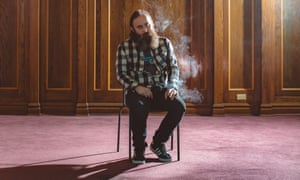Holy Smoke! The Church of Cannabis
t started, naturally, with a group of friends smoking a joint. Steve Berke, a graduate of Yale University, was temporarily living in an old church in Denver, Colorado. His estate agent parents had bought the 113-year-old building with the plan to turn it into flats. He and Lee Molloy, as well as a few friends, had just moved from Miami to capitalise on Colorado’s lucrative marijuana market. But then, in the words of Lee: “We started having these stupid, fantastical conversations. What if we kept it as a church?” So Steve convinced his parents to give him the building and, nine months later, on 20 April 2016 – 4/20, as it’s known in the United States, the unofficial pothead’s holiday (because it’s 4.20pm somewhere, right?) – the International Church of Cannabis opened its doors with its own chapel, theology and video game arcade.
From the outside all appears normal: red-brick towers, blocky turrets, a classic city church in an otherwise leafy suburb of Denver. But there are giveaways. The three front doors and arched window facade have been spray-painted with silver galaxies and bright, happy-face planets. The work of legendary painter and graphic artist Kenny Scharf, who has exhibited in the Whitney and New York’s Museum of Modern Art, it looks more like the backdrop for an illegal 90s rave than your typical parish church. But it’s indicative of the coup that Elevation Ministries, the non-profit company that Steve and Lee co-founded to set up the Church of Cannabis, has managed to pull off.
“That mural would probably buy you next door’s house,” Lee says, letting me in. But they got it for the price of an air ticket for Scharf, a few days’ skiing and the loan of a jacket. People love fantastical ideas.

The original plan was to open it to the general public, but because Colorado’s current pot law only allows smoking in private clubs, it is, for now at least, a members-only affair. To date they have more than 1,400 on their list. They open the doors from Thursday to Sunday for smoke-free public viewing, with private cannabis services held on Friday nights. It seems to be growing.
That’s not surprising. Medical marijuana was legalised in Colorado in 2000 – the first state to write it into its constitution. By 2009 dispensaries began popping up around the state and legalisation of recreational use soon followed in 2012. It has, for the most part, been wholeheartedly embraced. In 2016 Colorado sold more than a $1bn of weed, created thousands of new jobs and collected almost $200m in additional tax revenue. A church dedicated to cannabis may seem strange to us, but in Colorado it might just be the next logical step.
But there have been detractors. Currently, three of the founding members, including Lee, are under citation for two charges dating back to their opening 4/20 event: the first for breaking the Colorado Clean Indoor Air Act, which bans smoking in public places, and the second for breaking a state law that forbids marijuana consumption outside private homes and clubs. They refute the claims, and officials admit that they appear to have been adhering to the law since then, but a court date is pending.
Dan Pabon, from the state’s House of Representatives, goes further: in a recent interview with the New York Times he said that the new church – “offends both religious beliefs everywhere, as well as the voters’ intent on allowing legalisation of marijuana in Colorado”. He introduced an amendment that would ban pot use in churches, but to date it has failed to gather support. Overall, though, official opposition seems to be dwindling. Daniel Rowland, spokesman for the Denver city office, says: “As long as they operate within the law and don’t offend their neighbours, they’re free to do what they want.”

But what of those neighbours? Peter G Chronis, writing in local paper the Denver Post, said he felt “blindsided” – angry that the project was done in secret and that the neighbourhood didn’t have a chance to voice concerns prior to its completion. Parking and noise, rather than the consumption of marijuana inside, still seem to be the major worries, as well as the possibility that attendees will drive home stoned. But Lee is hoping to turn them round: arranging volunteer days through their church, to help make a positive impact in the community. Last Saturday they were out collecting rubbish from local streets. For now, at least, there seems to be a tentative truce.
But putting all beliefs and disputes aside, what everyone can surely agree is that they have transformed a near-derelict building into a staggering work of art. Every single surface has been painted in vibrant patterns of red, blue and green, geometric prisms with mythological creatures, stars and eyes hidden within. At the back wall, two dream-like Dali-esque giants sit cross-legged as if lost in meditation. “It feels like a hallucination,” someone says beside me, eyes careening upwards. It’s like being swallowed by a Pink Floyd album cover. Perhaps most impressive of all is that it was created spontaneously without a sketch or a plan. This was another freebie: they flew Spanish artist Okuda San Miguel over and bought him a bunch of paints, then he started work in one corner and painted whatever he dreamed up until he finished. It took him just six days – he rested on the seventh.
As the service begins we are encouraged to get to know each other: people spark up joints and pass them around. Long wisps of smoke float to the ceiling and cover the congregation in a flowery shroud; splutterings of coughs and giggles, the sharp intake of breath on all sides. There are about 30 of us in all, a mixed bag of misfits ranging from a self-proclaimed pothead granny, whose eyes appear to move independently of each other, to a couple of Harold & Kumar wannabies taking selfies at the altar. And then there’s Lee: a former Bible quiz champion, raised in a strict evangelical Christian home, he has the credentials of a preacher if not the look: bushy hipster beard and long messy hair, dark bags under his eyes and the whiff of old smoke on his shirt. It feels more like the start of an AA meeting than a spiritual encounter. But then he starts to speak.

“Being an elevationist [the term they’ve coined for the theology of the new church]means being an explorer,” Lee begins. “Our spiritual journey is one of self-discovery, not one of dogma. We believe there is no one-path solution to life’s big questions. This is simply a supportive place for each one of us to find a pathway to our own spirituality, whatever that may be.” Think of it like the pick ’n’ mix of belief. There is no doctrine, no creed, no scripture or book. Simply choose bits of whatever world religions work for you, or make something up yourself, mix it all together, and see if it tastes good. “There are as many pathways to being an elevationist as there are elevationists,” Lee says. Spirituality shouldn’t be a prescription; it should be an adventure. It’s about seeking, not being told what to find.
It’s an idea that will strike a chord with many people. Church attendance in the UK is on the decline. Last year only 1.4% of the population attended Sunday Anglican services – the lowest level ever recorded. There is a significant demographic of people who simply can’t relate to organised religion or outright oppose it on principle. Being able to explore your own path, within a supportive space, could help fill that widening spiritual deficit.
But here’s where they may lose you. That journey of self-discovery, says Lee, is enhanced by ritual cannabis use. “We have been programmed to behave and think in certain ways,” he says. “Cannabis helps elevationists tear down those false realities.”
It’s easy to baulk. Does watching Star Trek and eating peanut M&Ms count as a spiritual path? But, in fact, cannabis use has long been part of religion, from ancient Chinese shamans to modern-day Rastafarians: inducing altered states of consciousness has been a cornerstone of belief since time immemorial. And even without drugs, whether it’s spinning Sufi dancers or drumming voodoo priests, or even just simple prayer or meditation, taking the mind to a higher plane has always been a road to the divine, whatever you may conceive that to be.

Afterwards, we stay in the pews and talk. Yes, I get stuck in a 15-minute conversation about X-Men; yes, there is a lot of talk about ordering pizza and the downstairs “after-party” is a stoner’s paradise with ping-pong, board games, an entire table laid out with every munchie imaginable. But we really talk, too. There is Emilee, 26, who uses marijuana to help deal with chronic pain; and 40-something “Rockin” Ray, who started smoking as a teenager to help his Attention Deficit Disorder. “We want to keep the community part of church,” Lee had said, “the music and singing and seeing friends, but do away with the dogma.”
I sit back, head on the pew and let the psychedelic colours and smell of sensimilla smoke drift through my mind. This could be the start of something; it’s possible churches such as these will pop up all over the legalised States. But it may also just go up in smoke.
Find out more at elevationists.org


